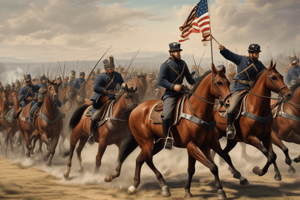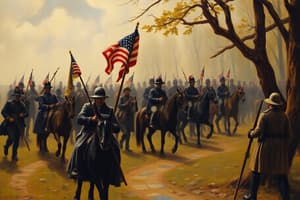Podcast
Questions and Answers
What was the primary reason for the South to refer to the Tariff of 1828 as the 'Tariff of Abominations'?
What was the primary reason for the South to refer to the Tariff of 1828 as the 'Tariff of Abominations'?
- It directly led to the secession of South Carolina
- It was the highest tariff in the history of the United States at that time
- It primarily benefited the Northern industries (correct)
- It was initiated by John C. Calhoun
What was the main purpose of the Nullification Crisis?
What was the main purpose of the Nullification Crisis?
- To assert state power over federal power
- To remove the Tariff of Abominations (correct)
- To secede from the Union
- To end slavery in the United States
What was the main idea behind popular sovereignty?
What was the main idea behind popular sovereignty?
- The idea that slavery should be abolished in all states
- The idea that the new territories and states should decide whether to have slavery through a popular vote (correct)
- The idea that slavery should only be allowed in Southern states
- The idea that the federal government should decide on the issue of slavery
What was the main purpose of the Gag Rule?
What was the main purpose of the Gag Rule?
Who was known as the 'Great Compromiser'?
Who was known as the 'Great Compromiser'?
What was the main outcome of the Compromise of 1850?
What was the main outcome of the Compromise of 1850?
What is the primary difference between the North and South's industries?
What is the primary difference between the North and South's industries?
What was the significant impact of the cotton gin on the South's economy?
What was the significant impact of the cotton gin on the South's economy?
What was the main goal of abolitionists like William Lloyd Garrison and Frederick Douglass?
What was the main goal of abolitionists like William Lloyd Garrison and Frederick Douglass?
What was the significance of Harriet Tubman's role in the Underground Railroad?
What was the significance of Harriet Tubman's role in the Underground Railroad?
How did the population of the North and South differ?
How did the population of the North and South differ?
What best describes the concept of sectionalism?
What best describes the concept of sectionalism?
Flashcards are hidden until you start studying
Study Notes
Sectionalism
- Sectionalism is when people focus on the needs of one section of the country, rather than the needs of the country as a whole.
North and South Differences
- The North had an industry based on factories and manufacturing.
- The North had more railroads, making it easier to trade goods.
- The North had a larger population and more urbanized cities.
- The South's industry focused on agriculture, with many plantations growing cotton.
- The South relied heavily on slavery to maintain their plantations and economy.
- Half of the South's population was made up of slaves.
Eli Whitney and the Cotton Gin
- Eli Whitney invented the cotton gin, a machine that could separate cotton from its seeds quickly.
- The cotton gin made cotton production easier and increased the demand for slaves.
Abolitionists
- An abolitionist is someone who opposes slavery and wants it abolished.
- William Lloyd Garrison wrote the newspaper "The Liberator" and started petitions and protests against slavery.
- Frederick Douglass was a former slave who wrote about his experiences and spoke out against slavery.
- Harriet Tubman helped slaves escape through the Underground Railroad and spoke about her experiences as a slave.
- Harriet Beecher Stowe wrote "Uncle Tom's Cabin", which highlighted the horrors of slavery.
Causes of the Civil War
Tariff of Abominations
- The Tariff of Abominations was a tax on imported goods that protected the North's industry.
- The South opposed the tariff, as it hurt their economy and reliance on European trade.
Nullification Crisis
- The Nullification Crisis was a dispute between the South and the government over the Tariff of Abominations and state power.
- South Carolina threatened to secede from the Union if the tariff was not repealed.
John C. Calhoun
- John C. Calhoun was a southern politician who threatened to secede if the tariff was not repealed.
Slavery
Free Soil
- Free soilers opposed the spread of slavery to new states and territories, but did not want to remove slavery from existing states.
Popular Sovereignty
- Popular sovereignty was the idea that new territories and states should decide whether to allow slavery through a popular vote.
Gag Rule
- The Gag Rule was a law that tabled any legislation and petitions dealing with slavery, introduced due to the chaos and disputes caused by the petitions.
Compromises
Missouri Compromise
- The Missouri Compromise allowed Missouri to enter the Union as a slave state and Maine as a free state.
- The compromise also established the 36°30' line, where states above the line were free and those below were slave states.
Henry Clay
- Henry Clay was the "Great Compromiser" who created the Missouri Compromise and Compromise of 1850.
Compromise of 1850
- The Compromise of 1850 allowed California to enter the Union as a free state, outlawed the slave trade in Washington D.C., and established boundaries between Texas and Mexico.
Stephen Douglas
- Stephen Douglas worked with Henry Clay to form the Compromise of 1850.
- He argued for popular sovereignty and opposed Lincoln.
Fugitive Slave Act
- The Fugitive Slave Act had three parts, including:
- The act allowed for the capture and return of escaped slaves.
- The act created a system of commissioners to handle fugitive slave cases.
- The act imposed penalties on those who aided escaped slaves.
Studying That Suits You
Use AI to generate personalized quizzes and flashcards to suit your learning preferences.




